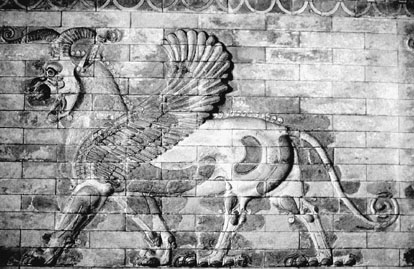

 | Page 678 |  |
Hamadan (the ancient Median capital, Ecbatana) in the late nineteenth century reported that excavation for antiquities in large areas in and around the city was a systematic industry farmed out by the government for revenue. There was also a thriving production of fake antiquities, mostly coins, for the European market.

Griffin-lion shown in tiled relief, from a royal site (probably Persepolis or Susa), fourth century B.C.
(Image Select)
The modernizing reforms of Nasir al-Din, the most able of the Qajar shahs, brought about his assassination in 1896. His successors were either ineffectual or despotic, and the period leading up to World War I was one of great internal turmoil that culminated in the invasion of northern and southern Iran by Russia and Britain, respectively. In 1911, members of the first Majlis (National Assembly) introduced a bill designed to cancel the French archaeological monopoly, but by 1913, the French ambassador had successfully arranged for the bill to be shelved. The war brought excavations to an end though sir aurel stein conducted a survey in Seistan in 1915–1916. De Mecquenem remained in Iran until the end of the war to protect French archaeological interests.
French control of archaeology continued until 1927 when it was finally abolished by Reza Shah Pahlavi (1925–1941). As a concession, the shah established an archaeological museum and library in Tehran and appointed a French director-general of antiquities responsible for establishing an archaeological service, making an inventory of historic monuments, and carrying out necessary restorations. The position was taken in September 1927 by a French architect, Andre Godard, who held it until 1960. Godard’s achievements were considerable: he created the necessary administration, the Iranian Archaeological Service (IAS), and established the Muze Iran Bostan (now the National Museum of Iran) and oversaw its construction in Tehran between 1935 and 1937. He also conducted important work on Islamic architecture and supervised the restoration of historic buildings, especially in Isfahan. In 1931, when the antiquities market was being flooded by Luristan bronzes from illegal excavations in central-west Iran, Godard wrote what became the standard text on the bronzes. He was also vigorous in the
 |  |